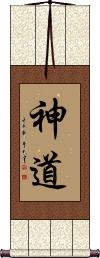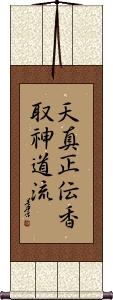Many custom options...
And formats...

神道 in Chinese / Japanese...
Buy an 神道 calligraphy wall scroll here!
Personalize your custom “神道” project by clicking the button next to your favorite “神道” title below...
Shinto
Katori Shinto-ryu
Shinto Muso-Ryu
Tenshin Shoden Katori Shinto-ryu
Not the results for 神道 that you were looking for?
Below are some entries from our dictionary that may match your 神道 search...
| Characters If shown, 2nd row is Simp. Chinese |
Pronunciation Romanization |
Simple Dictionary Definition |
神道 see styles |
shén dào shen2 dao4 shen tao jindou / jindo じんどう |
More info & calligraphy: ShintoShinto; Shintoism; (surname) Jindō The spirit world of devas, asuras, and pretas. Psychology, or the doctrines concerning the soul. The teaching of Buddha. Shinto, the Way of the Gods, a Japanese national religion. |
俗神道 see styles |
zokushintou / zokushinto ぞくしんとう |
(term used by Reform Shintoists) (See 復古神道) Folk Shinto; syncretized Shinto sect |
古神道 see styles |
koshintou / koshinto こしんとう |
(hist) ancient Shinto (as practiced prior to the introduction of Confucianism and Buddhism to Japan) |
明神道 see styles |
myoujindou / myojindo みょうじんどう |
(place-name) Myōjindō |
橘神道 see styles |
tachibanashintou / tachibanashinto たちばなしんとう |
(See 垂加神道) Tachibana Shinto (Edo-period sect of Suika Shinto popularized by Mitsuyoshi Tachibana) |
神道家 see styles |
shintouka / shintoka しんとうか |
Shintoist |
神道寺 see styles |
kandouji / kandoji かんどうじ |
(place-name) Kandouji |
神道山 see styles |
jindousan / jindosan じんどうさん |
(place-name) Jindousan |
神道教 see styles |
shén dào jiào shen2 dao4 jiao4 shen tao chiao |
Shinto |
神道集 see styles |
shintoushuu / shintoshu しんとうしゅう |
(work) Shintoshu (14th century Japanese Shinto text); (wk) Shintoshu (14th century Japanese Shinto text) |
一実神道 see styles |
ichijitsushintou / ichijitsushinto いちじつしんとう |
(abbreviation) (rare) (See 山王一実神道) Ichijitsu Shinto (alt. name for Hie Shinto: a form of Shinto heavily influenced by Tendai) |
三輪神道 see styles |
miwashintou / miwashinto みわしんとう |
(See 両部神道) Miwa Shinto (sect of amalgamated Shinto developed in the Muromachi Period) |
両部神道 see styles |
ryoubushintou / ryobushinto りょうぶしんとう |
Shinto-Buddhist amalgamation; dual-aspect Shinto |
伊勢神道 see styles |
iseshintou / iseshinto いせしんとう |
Ise Shinto (school of Shinto established the Watarai family priests of Ise Jingu's Outer Shrine) |
伯家神道 see styles |
hakkeshintou; hakukeshintou / hakkeshinto; hakukeshinto はっけしんとう; はくけしんとう |
Hakke Shinto (Shinto tradition transmitted by the House of Hakuo Shirakawa); Hakuke Shinto |
倭文神道 see styles |
shitoorijindou / shitoorijindo しとおりじんどう |
(place-name) Shitoorijindō |
儒家神道 see styles |
jukashintou / jukashinto じゅかしんとう |
Confucian Shinto |
吉川神道 see styles |
yoshikawashintou / yoshikawashinto よしかわしんとう |
Yoshikawa Shinto (Confucianist form of Shinto, stripped of Buddhist influence) |
吉田神道 see styles |
yoshidashintou / yoshidashinto よしだしんとう |
Yoshida Shinto; fusion of Shinto, Buddhism, Confucianism and Taoism stressing traditional Japanese elements |
国家神道 see styles |
kokkashintou / kokkashinto こっかしんとう |
(hist) State Shintō; nationalistic and ideological form of Shinto, abolished in 1945 |
垂加神道 see styles |
suikashintou; shidemasushintou / suikashinto; shidemasushinto すいかしんとう; しでますしんとう |
Suika Shinto (fusion of Shinto with Chinese elements, esp. neo-Confucianism); Shidemasu Shinto |
天台神道 see styles |
tendaishintou / tendaishinto てんだいしんとう |
(rare) (See 日吉神道) Tendai Shinto (alt. name for Hie Shinto: a form of Shinto heavily influenced by Tendai) |
山王神道 see styles |
sannoushintou / sannoshinto さんのうしんとう |
Sanno Shinto (branch of Shinto formed in the Tendai school of Buddhism) |
弓矢神道 see styles |
yumiyashintou / yumiyashinto ゆみやしんとう |
(See 吉田神道) Yumiya Shinto (Edo-period sect of Yoshida Shinto) |
御流神道 see styles |
goryuushintou / goryushinto ごりゅうしんとう |
(See 両部神道) Goryū Shinto (sect of amalgamated Shinto) |
復古神道 see styles |
fukkoshintou / fukkoshinto ふっこしんとう |
Fukko Shinto; Restoration Shinto; Reform Shinto (prominent 18th century form of Shinto, based on the classics, and free from Confucian and Buddhist influences) |
教派神道 see styles |
kyouhashintou / kyohashinto きょうはしんとう |
Sect Shintō; group of folk religious sects, as opposed to State Shintō and later Shrine Shintō |
日吉神道 see styles |
hieshintou / hieshinto ひえしんとう |
(rare) (See 山王一実神道) Hie Shinto (form of Shinto heavily influenced by Tendai) |
横山神道 see styles |
yokoyamashintou / yokoyamashinto よこやましんとう |
Yokoyama Shinto (Edo-period Shinto sect promoted by Masae Yokoyama) |
法華神道 see styles |
hokkeshintou / hokkeshinto ほっけしんとう |
(See 法華宗・1) Hokke Shinto (Shinto doctrines based on Nichiren Buddhism) |
Click here for more 神道 results from our dictionary
The following table may be helpful for those studying Chinese or Japanese...
| Title | Characters | Romaji (Romanized Japanese) | Various forms of Romanized Chinese | |
| Shinto | 神道 | shin tou / shin dou shintou / shindou shin to / shin do | shén dào / shen2 dao4 / shen dao / shendao | shen tao / shentao |
| Katori Shinto-ryu | 香取神道流 | ka tori shin tou ryuu katorishintouryuu ka tori shin to ryu | ||
| Shinto Muso-Ryu | 神道夢想流 | shin tou mu sou ryuu shintoumusouryuu shin to mu so ryu | ||
| Tenshin Shoden Katori Shinto-ryu | 天真正伝香取神道流 | ten shin shou den ka tori shin tou ryuu ten shin sho den ka tori shin to ryu | ||
Successful Chinese Character and Japanese Kanji calligraphy searches within the last few hours...







